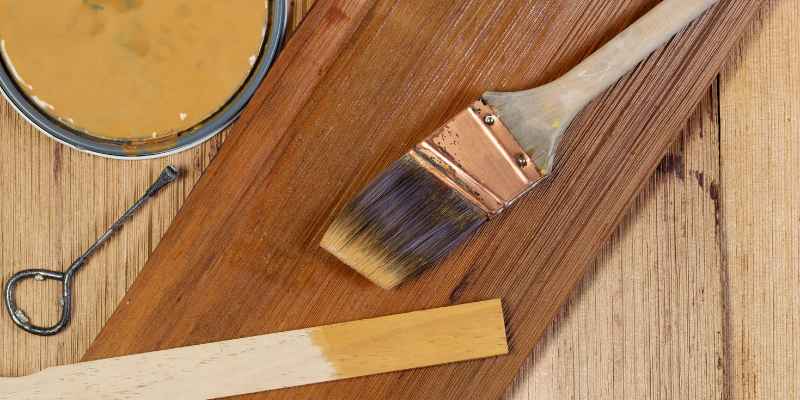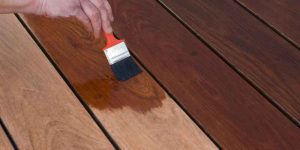To bring out wood grain without staining, use a penetrating oil like tung oil, walnut oil or double boiled linseed oil. Wet the wood with a rag and let it dry before applying the oil.
Apply with a brush or cloth and let it sit for 15-20 minutes before wiping off the excess. This will enhance the natural characteristics of the wood grain and add warmth and color. If you’re looking for a natural and effective method to bring out the wood grain in your furniture or floors, then using a penetrating oil like tung oil, walnut oil or double boiled linseed oil is the best choice.
It not only enhances the natural characteristics of the wood grain, but also adds warmth and color to your wood. We’ll explore the benefits of using a penetrating oil, how to apply it, and some other useful tips to bring out the wood grain without staining. So, let’s get started!
Methods Of Enhancing Wood Grain
There are several methods for enhancing wood grain without staining. Using a penetrating oil such as tung oil or walnut oil is one of the best ways to bring out the natural characteristics of the wood grain. Additionally, you can wet the wood with water to raise the grain and open up the texture.
Wood is a fantastic material that comes in diverse and naturally beautiful grain patterns. Whether you are a woodworker or a homeowner, enhancing the natural grain of wood is one way to upgrade your space’s aesthetic value. However, not everyone wants to use wood stain to achieve this look. Luckily, there are other methods of enhancing wood grain. Let’s explore some of these methods below.
Using A Grain Enhancer
One way to bring out wood grain without staining is to use a grain enhancer. Unlike wood stain that alters the wood’s color, a grain enhancer is usually a clear product that enhances the wood’s natural grain. You can apply a grain enhancer using a lint-free cloth or a paintbrush. It is recommended to apply the enhancer against the grain to allow it to penetrate deep into the grain pattern. Afterward, you can wipe away the excess enhancer and let it dry overnight.
Using A Penetrating Oil
Using a penetrating oil is another method of enhancing wood grain. Applying a penetrating oil such as Tung oil, Walnut oil, or boiled Linseed oil will not only nourish the wood but also enhance its natural grain. Unlike paints, oils penetrate deep into the wood, and with each coat, the wood’s grain becomes more visible. You can apply oil using a bristle brush, a lint-free cloth, or a spray gun depending on your preference.
Raising The Grain With Water
Raising the grain with water is a technique used to make the wood grain more visible before applying a clear finish. To raise the grain, lightly dampen the wood surface with a wet cloth. The water will cause the wood grain to swell, emphasizing the natural pattern. After the wood dries, you can lightly sand it with sandpaper to remove any roughness. You should repeat the process until the wood grain is as visible as you prefer. Finally, you can apply a clear finish to the wood.
Using Black Walnut Hulls
If you prefer to use natural products, black walnut hulls are an excellent option for enhancing the wood grain. Crush the black walnut hulls into small pieces, put them in a jar, and cover them with water. Let the mixture steep for a few days. The tannins in the hulls will seep into the water, creating a dark liquid that can enhance the wood grain. You can apply the liquid to the wood surface using a paintbrush, a cloth, or a spray gun. The longer you steep the mixture, the darker the liquid becomes.
In conclusion, bringing out wood grain without staining is possible using a variety of methods. From using a grain enhancer, a penetrating oil, raising the grain with water to using black walnut hulls, the options are varied and work well depending on the wood type and the desired aesthetic value. Try these methods, and you’ll love the resulting look and feel of your wood surface.
Preparing The Wood

Prepare the wood by wetting a clean rag with water and wiping down the surface. The water will penetrate the wood, raising the grain and opening it up. Let the wood dry before proceeding. Using an oil-based penetrating oil like tung oil, walnut oil or double boiled linseed oil is the best method for bringing out the natural characteristics of wood grain without staining.
Preparing the wood is the first step in bringing out the wood grain without staining. In this process, you need to make sure that your wood is free from dirt, debris, and contaminants such as oil, grease, and wax. This helps the wood grain to reveal its natural beauty.
Cleaning the wood:
To clean the wood, you can use a cloth or a soft-bristled brush to remove any dirt and dust. It is essential to avoid using water at this stage as it can cause the grain to raise up, making it more challenging to sand later. For removing any oily or greasy substances, use a soft cotton cloth soaked in denatured alcohol or mineral spirits.
Sanding the wood:
Once the wood is cleaned, you need to sand it to bring out the wood grain more visibly. Use sandpaper with 120-grit or 150-grit to roughen the wood surface. Sanding your wood will flatten the wood surface, making it ready to accept any treatment that you decide to use.
Using wood filler:
If your wood has any knots or defects, you need to fill them with wood filler before you proceed. This will give your wood surface a smooth and even finish. To fill the gaps, use wood filler that is water-based and natural-colored. Apply it with a putty knife and leave it to dry for two to four hours. Once it is dry, sand it again with 150-grit sandpaper to ensure a smooth finish.
By following these simple steps of preparing the wood, and using the wood filler, sandpaper, and proper cleaning techniques, you can bring out the wood grain without staining.
Applying The Finish
To bring out the wood grain without staining it, start with bare wood and use penetrating oils like Tung oil, Walnut oil, or double boiled Linseed oil. Wet the wood with water and let it dry before applying a clear finish.
Avoid darkening wood by using a concentrated solution of crushed black walnut hulls soaked in water instead of traditional staining techniques.
Choosing The Right Clear Finish
Choosing the right clear finish for your wood is essential in bringing out the wood grain without staining. The clear finish will help protect the wood while enhancing its natural features. There are many different types of clear finishes to choose from, including varnish, lacquer, and polyurethane.
Applying The Finish Evenly
Before applying the clear finish, it is crucial to ensure that the wood is clean and dry. Any dust, dirt, or debris will ruin the finish, creating an uneven or streaky appearance. Once the wood is clean and dry, apply the clear finish with a natural bristle brush or sprayer, taking care to apply it evenly and with the grain. Avoid over-applying the finish as this can cause drips and runs.
Removing Excess Finish
After applying the clear finish, it is essential to remove any excess. Use a clean, dry cloth or a tack cloth to wipe away any drips or runs. If you allow the excess to dry, it can create an uneven or rough texture, ruining the finished look. Be sure to remove any excess finish, taking care not to remove too much and expose the wood too soon.
In conclusion, bringing out the natural wood grain without staining is a process that requires the right clear finish and application technique. Choosing the right clear finish, applying it evenly, and removing excess finish can help bring out the beauty in your wood while providing protection and durability.
Finishing Techniques For Specific Types Of Wood
When it comes to bringing out wood grain without staining, using a penetrating oil like Tung oil or Walnut oil can be the best method. Wetting the wood with water can also raise the grain and open up the wood’s natural characteristics.
Avoiding staining altogether can enhance the natural appearance of wood.
Wood grain is one of the most beautiful and unique aspects of natural wood. It’s easy to see why so many people prefer to enhance the natural characteristics of wood instead of covering them up with a layer of stain. There are several techniques you can use to bring out the wood grain without staining, and these techniques work best when customized to the specific type of wood you are working with. In this post, we’ll explore some finishing techniques for specific types of wood, including curly maple, sugi ban, pine, and burnt wood.
Finishing Curly Maple
Curly maple is a popular wood choice for furniture, flooring, and cabinetry. To bring out the unique grain of curly maple, you’ll want to apply an oil-based finish. Tung oil, walnut oil, or double boiled linseed oil are all excellent options for enhancing the grain of curly maple. You can also use grain filler to fill in any small voids or imperfections in the wood.
Sugi Ban Technique
Sugi ban is a Japanese technique that involves charring wood to bring out its natural beauty and texture. To achieve this effect, you’ll need to use a propane torch or another heat source to burn the surface of the wood. After burning, gently brush away the charred debris and finish the wood with a clear oil or varnish.
Finishing Pine
Pine is a softwood with a subtle and distinct grain pattern. To enhance the natural grain of pine, you’ll need to use a pre-stain wood conditioner. This will help the wood absorb the stain or finish more evenly and prevent blotchiness. After applying the conditioner, apply a clear oil or varnish to bring out the natural color and grain of the wood.
Burnt Wood Technique
The burnt wood technique is a popular option for those looking to create a unique and rustic appearance on their wood project. To achieve this look, use a propane torch or heat gun to burn the surface of the wood. Be careful not to overdo it, as too much heat can cause the wood to become brittle or even catch fire. After burning, gently brush away the charred debris and apply a clear oil or varnish to protect the wood.
In conclusion, bringing out the natural grain of wood is a great way to showcase its unique beauty and texture. These finishing techniques for specific types of wood can help you achieve the desired effect without using staining. Whether you’re working with curly maple or pine, or using the sugi ban or burnt wood technique, these tips can help you create a stunning finished product.
Common Issues And How To Avoid Them
To bring out wood grain without staining, use a penetrating oil like Tung oil or Walnut oil. Wet the wood down with water to cause the grain to raise up and open. Let it dry before proceeding and apply the oil with a cloth or brush for best results.
Avoid using a finish that may darken the wood.
Uneven Or Blotchy Finish
Uneven or blotchy finish is a common issue when trying to bring out wood grain without staining. It usually happens when there is an inconsistency in the application of the finishing product. To avoid this issue, it’s important to sand the wood before applying the finishing product. This will remove any imperfections on the surface and create an even base for the finish. It’s also important to apply the finishing product uniformly and allow enough drying time before applying additional coats.
Dust Particles In Finish
Dust particles in finish can leave undesirable marks on the wood surface, making it look unattractive. To avoid this issue, it’s important to keep the workspace clean and free of dust. Before applying the finishing product, it’s essential to clean the surface of the wood with a tack cloth to remove any dust particles that might have accumulated during sanding. It’s also important to avoid working in areas with a lot of dust.
Over-application Of Finish
Over-application of finish is the most common mistake people make when trying to bring out wood grain. This can lead to a sticky surface that takes longer to dry and can even damage the wood. To avoid this issue, always follow the manufacturer’s instructions on how much finishing product to apply. It’s better to apply thin, even coats and let them dry completely before applying additional coats. Applying too much finishing product at once will not only cause an uneven finish, but it can also darken the color of the wood.
To bring out wood grain without staining, it’s important to be aware of common issues and how to avoid them. By following the tips mentioned above, you can achieve a beautiful, natural-looking finish on your wood surfaces. Remember to always sand the wood beforehand, keep your workspace clean, and follow the instructions on the finishing product label for best results.

Frequently Asked Questions On How To Bring Out Wood Grain Without Staining
How Do You Make Wood Grain More Visible?
To make wood grain more visible, the best approach is to use a penetrating oil like Tung oil, Walnut oil, or double boiled Linseed oil. Wetting the wood down with water can also raise the grain and make the wood grain more visible.
Additionally, applying a grain enhancer against the grain and wiping it away can improve the visibility of the wood grain. Black walnut hulls soaked in water can also be used to darken the wood without staining it.
How Do You Get The Grain Out Of Wood Before Staining?
To get grain out of wood before staining, wet a clean rag with water and wipe the wood down with it. Don’t flood the surface, but make sure it gets wet enough to penetrate the wood and raise the grain.
Let the wood dry before proceeding. Using penetrating oils like Tung oil, Walnut oil or double boiled Linseed oil can bring out the natural characteristics of the wood grain. Crushed black walnut hulls soaked in water can darken the wood surface naturally.
What Is The Best Finish To Bring Out Natural Wood Color?
Penetrating oils like tung oil, walnut oil, or double boiled linseed oil are the best finishes to bring out natural wood color. Apply the oil with a cloth or brush for best results. Another method is to wet the wood with water to raise the grain and open the wood pores for better absorption of the oil.
Avoid staining to keep the natural appearance of the wood.
How Do You Darken Wood Without Staining It?
To darken wood without staining it, crush black walnut hulls and soak them in water to create a concentrated solution. Apply the solution to the wood surface to achieve a darker color. This method works best on lighter woods like pine and maple.
You can also use penetrating oils like Tung oil, double boiled Linseed oil, and Walnut oil to bring out the natural grain of the wood. Wet a clean rag with water and wipe the wood down to raise the grain and open the natural wood characteristics.
Conclusion
Bringing out the natural grain of wood can enhance the beauty of any woodwork. While staining is a popular way to achieve this effect, it is not the only method. By using some of the techniques we have explored such as sanding the surface and applying a clear finish or using penetrating oils, you can bring out the natural beauty of wood grain without staining.
Experiment with different methods to find the one that works best for you and bring your woodworking projects to life with stunning wood grain patterns.


